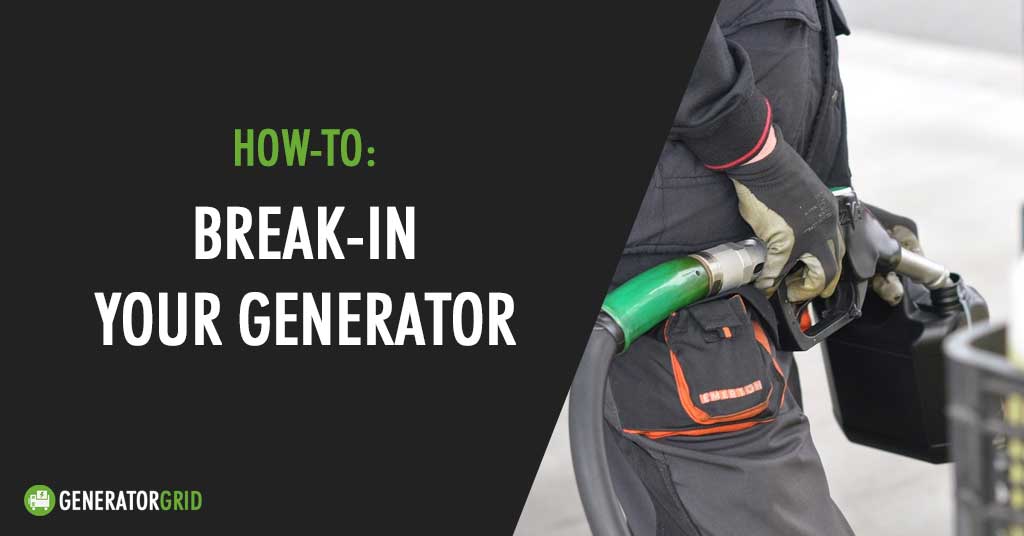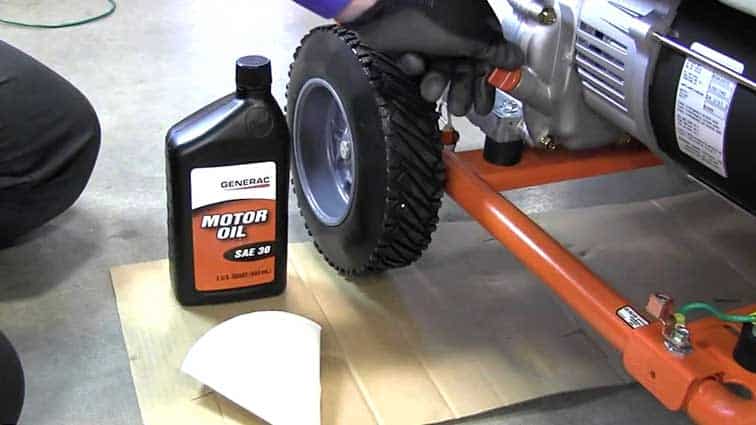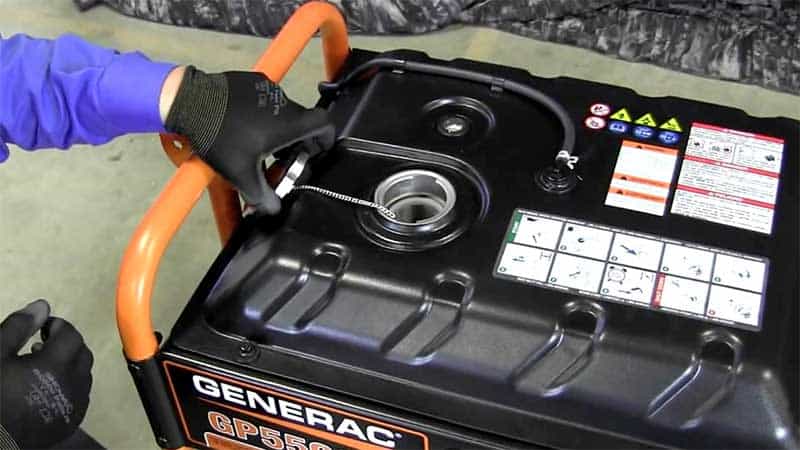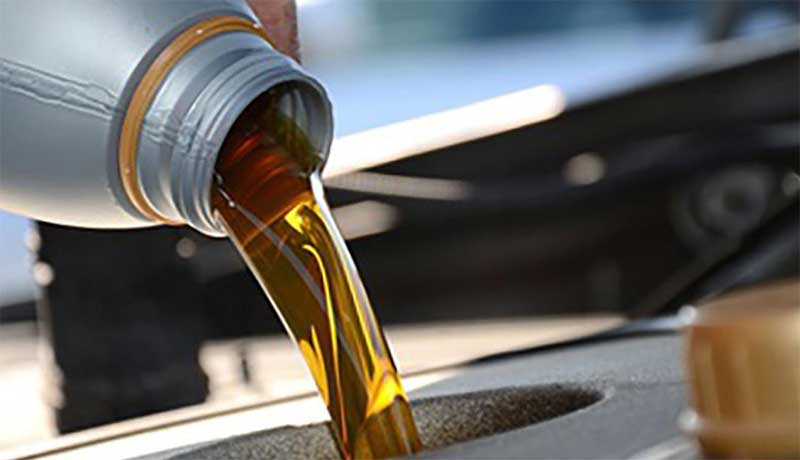Last Updated on May 3, 2023 by Rod Olivares

Did you know that what you do in the first few hours of owning a portable generator can have a big impact on how long it will last?
If you don’t carefully break in your generator, you will almost certainly have big problems before you know it.
Why Do I Need to Break in My New Generator?
When you don’t take the time to properly break in your new portable generator, you’re risking some pretty serious damage.
You’re also likely just shortening its lifespan. Buying a portable generator is an investment and it’s something that you should expect to last for quite some time.
If you don’t carefully break it in, though, all bets are off.
The process for breaking in a generator is a cycle of letting it run and changing the oil.
It’s important to let it run so that oil can circulate throughout and cover all moving parts.
But it’s also important for another reason: when engines are new, tiny pieces of metal are likely to break off and move around in the engine.
This can cause some serious engine wear, so if you care about the longevity of your portable generator, it’s vital to follow these instructions for breaking it in properly.
How-to: Step by Step
It takes a few hours, but the process for properly breaking in a generator is quite easy, even if you don’t know much about engines. Follow these steps and your generator should be working well for years to come.
1. Go shopping.

Before you can break in your generator, you need oil, gas, and a few other supplies.
- For gas, you should buy the highest-octane gasoline you can get.
- For oil, you should buy the oil brand recommended by the generator’s manufacturer.
You should also buy an oil conditioner like Lukas Heavy Duty Oil Stabilizer or Marvel Mystery Oil.
Dry starts are a major cause of wear in engines, especially new engines.
Adding some oil conditioner will ensure that there isn’t a dry start.
These products have special properties that help the oil stick to the cylinder walls. This means that even if your generator has been sitting around for a long time without being used, you can trust that the internal parts aren’t dry and at risk for faster wear.
2. Start the lubrication process.
Remove the spark plug. Using a funnel, pour just a little bit of the oil conditioner down into the spark plug chamber.
This helps ensure that there is some lubrication in the cylinder before you yank the cord to start the generator up the first time.
You should never pull the starter cord before there is some lubrication on that cylinder wall.
After the conditioner is in, pull on the starter cord slowly about 10 times.
This allows the piston to move up and down in that newly lubricated cylinder.
Replace the spark plug.
3. Add the oil.

First, squeeze some oil conditioner right into the crankcase. Using a funnel, fill up your portable generator with the appropriate amount of oil. Check the manual to see how much oil your generator takes.
4. Add the fuel.
Next, fill the tank up with gasoline.
It’s a good idea to use high-grade gasoline whenever possible.

Open the vent and switch it to the on position. Turn on the choke and then start the generator up.
It might take some extra pulls for this first start, so don’t be alarmed if it doesn’t start after the first pull on the cord.
5. The first hour.
Let it run for one hour at the lowest speed. It’s extremely important to let it run for this first hour on no load whatsoever.
6. Change the oil.

After letting it run for 60 minutes with no load whatsoever, it’s time to drain the oil.
This helps get rid of the majority of those metal flakes and fragments.
Getting these out will prevent serious wear on the engine. Add some more oil conditioner and fill it up with fresh oil.
7. The second hour.
Start it up again and let it run for another hour at no load.
8. Change the oil again.
After the second hour, power down and change the oil one more time. Once again, add some oil conditioner.
You’ll notice that the oil will be significantly cleaner than it was after the first hour.
9. The third and final hour.
Start it up for hour number three. This time, you should add a bit of load, around 500W is recommended.
After this third hour, your generator is officially broken in and you can start using it normally.
Other Considerations
If you live in an area where it’s hard to find gasoline without some amount of ethanol in it, you should add something like Sea Foam Motor Treatment to the gas.
This acts as a cleaner, inhibitor, and stabilizer for the fuel.
You should generally add 1-2 ounces per gallon to your fuel for best results.
Ethanol can cause a lot of damage to various generator components, and a product like Sea Foam can help mitigate this damage.
Although it’s the first few hours that are the most important, don’t forget about regular maintenance over the course of the generator’s lifetime.
Always follow the manufacturer’s recommendations for maintenance schedules, as laid out in the manual.
Just like with a car, regular maintenance can be easy to put off–but it’s incredibly important.
Luckily, most portable generator maintenance doesn’t take much time or effort. It just has to be done! Whenever you change the oil on your portable generator, it’s a good idea to add some oil conditioner.
Did you find this guide helpful? Let me know in the comments bellow if you have any questions!

Scott Krager purchased generatorgrid.com in the summer of 2020 and quickly began to buy every generator under the sun! He currently has over a dozen generators and the number is growing quickly. He lives in Portland, OR near his family and friends.
GeneratorGrid.com is an independent review business. I am not affiliated with any manufacturers and do not accept paid reviews. When you buy through my links, I may earn a commission which helps me purchase more generators for testing. - Scott Krager


Step 9 of this process. You have 500W. This is the recommended wattage for what size generator? In other words what percent of watts is 500w for that particular generator? Mine is 7000w.
Hy Byron, This is not critical, 500 to 1000W will do
Thank you for that awesome knowledge and sharing it with all of us God bless Welter
Can you use 4 cycle break in oil to do this procedure like Maxima premium break in oil 10w 30 high performance engine oil could you send me back a email and let me know God bless Walter
Hello; generatorgrid great advice with regard to gen-break-in.
thank you. Tom
I followed your advice. Yes the first oil change showed very dirty as you said. I used 5w-30 conventional oil the three changes then I went over to full sym 5w-30. Syn oil lubes better and it handles high temps better
Thanks for the heads-up on generator break-in. Appreciate you taking the time to post, and will follow your instructions.
Damian: I also went over to full synthetic Amsoil small engine oil.
This is great advice here for breaking in any brand new small motor. I know a lot of people will not follow the advice of using a high-grade gas, even though it will save a lot of headaches later on. Case in point: I bought a riding mower from Lowes, that they used to mow their grass around the store. They used the cheap gas in it and the mower was spitting, sputtering and backfiring when I got it. After running two tanks of 91 octane through the mower, it runs like it is brand new and it does about 2x the work on a single tank of gas now. Did not do anything else to the mower to get this. If people are thinking of using the cheaper gas to save money, don’t. It will cost you more in the long run.
Hi Will.. does this high octane advice apply also to my new Ford Thor Axis RV.
Recommended fuel 87 octane..
Appreciate your advice..
No, you use whatever is recommended.
87 is normal for a work truck like the Ford F53 that you have.
Higher octane means it is harder to ignite, so the pistons don’t fire at different millisecond rates. High octane is needed in a Ferrari that has a precision engine and expects the pistons to fire at very specif timings, using low octane will cause it to kick and stutter.
A Ford V10 box truck like you have doesn’t care about precision and in fact can end up losing power with higher octane, the higher compression gives more power, not being able to make that high compression will lose power and cost you more at the pump
So is too late if youve started it without putting oil in the cylinder. Wasnt ran long maybe a minute
Sounds like good advice was offered. …I did not realize that high test gas was mentioned….my instruction sheet just stated to use fresh gas. I always do and I also out in Stay-bill gas stabilizer.
Hi, and thanks for the informative article. Two questions come to mind.
1. When you mention “high-grade” gasoline, do you just mean name-brand (Mobil, Gulf, Sunoco, etc.) vs no-name or do mean premium (91 or 93 octane vs 87)?
2. Rather than long term storage (draining gas, etc.), would it be just as beneficial to just run the thing for a half hour or so every couple of weeks all year long?
Hi,
1: Follow the manufacturer’s recommendation on octane and get it from a station that does a lot of business to ensure it’s fresh. Non-ethanol gas is a good recommendation in any use case where the engine sits unused for extended periods. Also, use a fuel stabilizer and the replace the fuel once a year. Doing it on your birthday helps you remember.
2: Yes that is definitely fine if you run it every week or so and don’t mind doing that.
I feel it is critical to run it every two weeks, I did all the time and then I got side tracked and forgot for a month and a half and the engine would hardly start when it did no matter where I adjusted the carb high and low jets it ran like crap and hard to keep running!Remember water settles to the bottom and condenses in the tank over time plus the ethanol in gas attracts water so with water is in bottom of carb collecting over a period of time without using cause gas to gum up and white gummy rust to form and clog up the minute fuel passages!I Had to fill carb with carb cleaner drain by removing jet ajustment screws,had to take out high speed jet and clean tiny holes in it put it all back together and it ran like a champ,remember even if it by a mircle did not get clogged you will be drawing water in the engine thru the carb because all the excess water condensation always seeks the lowest point which is in the carb or injection tube body!
i heard something about putting a different spark plug in ? also something about using diesel grade oil? can u comment, thx!
Iridium spark plugs have better longevity, but it’s not that big of a deal for generators. If you are looking to replace yours, E3 Spark plugs are better than most OEM due to the electrode design.
Regarding Oil, it depends if you intend to use it in lower temperatures, it may be easier to find a 5W-40 or 15W-40 diesel oil than gasoline oil.
Diesel grade oil used to be tougher than gasoline oils for a number of reasons, including higher viscosity and more robust detergency additives, but it isn’t really the case nowadays.
Just got my new generator and will be following this process. I did similar for my last unit and it worked well. The only addition to my process I found here was the oil conditioner. I’ll give that a go as every little bit helps with equipment that doesn’t run regularly.
One question, is ethanol free gas more important than the octane rating? In other words, should I use non ethanol 89 octane over 93 octane with ethanol. I believe the non-ethanol would take priority correct?
I have 1 hour on my Kohler Pro5.2E, noload. I will do my first oil change. Has been run mostly on idle. Used a half inch drill to bring it up to speed and let it throttle up and back down I will get some Lucas oil treatnent for it That is good advicr for the break in. Thanks
Very informative.
1) What is a little bit of conditioning oil? 1/2 to 1 oz?
2) Should you break in a new generator using gasoline or is propane fuel OK?
Planning on installing Hutch kit on new Honda 2200 but unsure if it should be
broken in with gasoline.
Hi George,
– Refer to the instructions on the bottle, it depends on Oil additive brands
– I would do a proper Gasoline break-in first
The prolonged running at idle equals low pressure and heat between the rings and cylinder wall, causing the rings and bore to glaze, or become shiny (higher oil consumption and loss of compression). It will also cause the oil slinger to sling less oil and reduce oil “misting”. It’s the oil that removes the heat from the internal
Pistons and rings are designed in such a way that the greater the explosion, the more the rings are forced out against the cylinder walls. This is the range that you want your rings to “bed in” for maximum efficiency under load.
To break a motor in (air cooled generator) I would use conventional oil and vary the load from the start, slowly increasing the load, but always bringing the motor down to idle or no-load condition every few minutes to cool down and let the oil remove the heat. Change the oil as often as you want, the more, the better. Once broken in, I would use Mobil 1 only (my personal choice) with no additives. Additives can have an effect on how the oil slinger does it’s job. If there was a magic additive, companies like Mobil would have added it and cornered the market.
This is my 2 cents worth, and how I break in new and rebuilt engines.
Cheers.
Derek, what should be the increasing-decreasing schedule that you mentioned.
Thanks!
Run the generator at fifty percent resistive load fifty percent duty cycle for twenty-four hours total time. Spaced out over time and not all at once. Proper break in is the most important thing for long lasting engine.
great tips!!! I just purchased 2 champion 2000 watt stackable inverter generators for my rv,,
as a new owner of this type of equipment,,, I wanted to make sure I was performing the break in period correctly,,, thanks!!
Just purchased a Champion 5500 watt duel fuel. Mfg. says : ” We consider the first 5 hours of run time to be the break-in period for the unit. During the break in period stay at or below 50% of the running watt rating and vary the load occasionally to allow stator windings to heat and cool. Adjusting the load will also cause engine speed to vary and help seat piston rings. After the 5 hour break-in period change the oil.”
20w50 shaffer oil all the way
We are about to purchase our first generator since we live in Florida and hurricanes seem to be getting worse. For many years, we just ‘ride them out’, but as we get older, we figured a generator would allow us some comfort, while power is off. This is a great article, and we’ll be sure to follow these instructions to prolong the life of generator. Thanks so much!!
Great tutorial and comments. I researched this before starting this new inverter generator (FIRMAN W03083) as to whether to use the supplied oil that comes with the generator (standard 10-30 oil) or go straight to full synthetic. This is my 3rd inverter generator (RV use). I have been thoughtful with care initially and throughout past generator break in and service but have not been quite as diligent as your tutorial recommends. Hard to tell how long they would have lasted as 1st one stolen after 4 years and second actually failed electronically after 2 years. Both were Champion 2000’s from Costco (which offer remarkable warranty) and appeared in pristine condition as i used them rarely and kept them clean and protected.
Based on tutorial and comments, I believe I will use the supplied oil for break in, then switch to synthetic on the second oil change post 1 hour of moderate operation.
Thank you.
When it says to put a bit of oil condition into the spark plug chamber, how much are we talking as I cant find any reference as to how much a little is please.
Thank you!
Running a generator or any small motor for one hour at no load is not a good way to break in the motor for longevity. Varying throttle settings (by applying load) and avoiding prolonged full throttle operation (max load) during the first hour or two will allow the piston rings to seat properly and other components to break-in. That combined with frequent oil changes will help ensure good internal motor health.
Followed the instructions. Gotta love marveral mystery oil, OG, my dad used it on his air guns as a kid. No joke, oil was clear in and the oil was dark gray with silt out the 1st change and grey the 2nd. May change a third time after 5 hours. Costco I power, Yamaha 2000 wt. Btw 52 decibels at 1/4 power.
My dad bought a generator and let it sit brand new, without ever starting it for about four years. What would you recommend for its first start up now?
Stephen, pull the spark plug and add just a little bit of a lubricant oil like the previously mentioned Marvels in the spark plug hole. The original article speaks of this process but everyone gets hung up on the amount used. If i had to put a quantity on it I would say around 1 teaspoon. Not enough won’t coat the cylinder wall and too much you’ll be fouling your spark plug. I have rebuilt 2 & 4 stroke engines so the initial start is very important on making sure there is lubrication. Less metal to metal contact is best!
Most genny’s are pre run in factory so all this 1hour and pre lubing cylinder is more of a easing your ocd then anything my firman 9500 watt I just bought says to change out oil 1st time after 25 hours then every 100 hrs thereafter. Ps you could see engine oil in mine new out of box although it had been drained they are run and drained in factory. My brothers generac he just bought new 10000 watt you could see had also been run and drained in factory.
Same with the brand new Honda 2200 I just bought. Oil was seen in the oil tank. I topped off the oil and then ran it for an hour…15 minutes no load, 15 minutes small load, 15 minutes larger load, 15 minutes no load. Drained the oil ( it was greyish ) and refilled and ran it for 1/2 hour. Was late so I’ll continue tonight with another 1/2 hour and then another oil change. My plan is to keep changing the oil till oil runs clean. I’m a big believer in oil being the #1 key to engine longevity…
most generators are run for a short time in the factory. And then the oil is drained. The main thing is make sure you use conventional oil for break in!
One thing you forgot to mention: Check valve clearances after the break-in, and again, after 50-100 hours. Some engine manufacturers recommend 3 hours full speed, no load, than change the oil. Others aren’t as concerned about how the engines is loaded, but universally, they ALL recommend that initial oil change after a very short initial operation period.
The original flat head Briggs and Stratton engines really didn’t have a convenient way to adjust valve clearances, but the modern over head valve engines do. By keeping up on the valve clearances, that will allow the engine to run more hours without any noticeable loss of performance.
You might want to add the oil first to the engine, then add about a tablespoon of Marvel Mystery Oil to the cylinder. You don’t want to pull with zero oil in the crankcase.
When pulling very slowly, with the plug missing, you should draw up some oil from the crankcase.
I am doing a 1 hour no load, change oil, then 4 more hours, one hour idling again, then with a varying load, electric heater outside for the last 3 hours.
The Champion just says load it up with oil, run it a bit no load, then vary it over 5 hours total. Change the oil, it is broken in.
That first hour run on Economy mode, aka no load, should pick up most of the metal.
Would be interesting to drop one of those strong magnetic into the oil after you have drained it to see if it picks anything up.
What you are trying to do after the first hour idle run, is to set the rings which requires varying loads. Also heating up and letting it cool down via of varying loads on the electric producing parts so they settle in.
When you store this thing, be sure to do the tablespoon of oil to the cylinder, slowly pull 10 times to lub the cylinder, it will help get rid of any moisture and lub the cylinder walls, protecting it from the air i.e. from rusting.
you said break in with conventional oil ….. first oil change be conventional and
can the second one be synthetic oil…is there a value to using synthetic
Rick,
I prefer synthetic oil AFTER break in, especially in air cooled engines, as they tend to run pretty hot. Synthetic oil resists thermal breakdown better than conventional oils.
Not all synthetic oils are created equal!!! 😉
The first two oil changes seem to be for the sole purpose of removing metal shavings. Any advice if the generator has an oil filter? I ran my new generator with no load for about 45 minutes yesterday after taking all recommendations and am not sure if I should bother changing the oil yet if my generator has a filter. I guess I’ll go ahead and change today and see what comes out. Also think the break in load of 500 watts might be too low for higher wattage units. You want to seat the rings by putting a load on the engine off and on. 500 watts might not put enough load on the engine of say a 10,000 watt unit.
Well written, practical and interesting. Thank you.
Invaluable advice! From a first-time generator owner with a VERY high-ticket item (for us) Thank you so much! What a blessing!!!
Thank you for your comment 🙂
If using propane exclusively does the generator still have to be broken in using gas?
Hello, My inverter generator have been stored for a year. Should I pour tablespoon of oil into spark plug hole before start it up? Thanks!
I had a generator and didn’t do any of this stuff and as you can imagine, it now doesn’t work!! I will follow your instructions for my new generator. Thank you so much!!
Great article!!!, I did the first 2 changes with 5w30 synthetic, and addd STP synthetic oil treatment. Next weekend will be the 3rd hour and load. Thank you !!!
Thanks for the break in information!! I’m replacing my old school 1500w PowerMate, with a Generac GP3000i, inverter generator. I was astonished at how dirty the oil was after an hour. So I ened up doing 4 run/drain cycles. By the 4th cycle, the used oil drained virtually clear. The final fill was done with Generac 5w30 synthetic. I have seen comments where some have used synthetic oil for the break in. I don’t think thats a good idea. The break in period is more than removing particulate matter and manufacturing coatings. You also want to seat the piston rings, seals, valves and other bearing surfaces. Synthetic oil is so good, that it can sometimes interfere with that process.
Hi Matt. Thanks for the helpful information. My first generator.
One question as to how much lube to put in the spark plug chamber. One person say a teaspoon another says a tablespoon. My generator is a 3500w inverter. Thanks for any help you can give me.
Purchased a Honda generator today and nowhere in the manual is this mentioned so thank you for your invaluable advice.
While I agree with your engine break in portion of the operation, have you considered the break in for the brushes? Brushes are carbon material that need to be worn in to full contact before introduction of electricity for best contact conditions and transfer of power to the output of the stator. If you put too much load on new brushes you may burn the stator as arcing occurs with poor contact. I would do as said and run no load for the hour and that start adding load after oil change a little at a time. I would also recommend that the oil be drained while hot as it flows better and more thoroughly at warm to hot temperatures. Cold oil will not carry the contaminants out the crank case as well as hot / warm oil does.
Another idea for a new generator:
(or any new small engine that doesn’t use an oil filter)
Buy one of those magnetic drain plugs. Install it before even starting the generator for the first time.
Of course this won’t help for the silicone gasket chunks and aluminum glitter that’ll be in the oil when draining it, but the magnet will pick up every microscopic speck of iron and steel.
It will look like a little mud on the magnet when you pull the plug to change the oil.
The generator I plan on purchasing is a v-twin with pressurized lubrication and an oil filter, should I replace the oil filter after each oil change or wait until the final oil change?
Wouldn’t necessarily call this the ‘right’ way unless you want to glaze your bore, as you can read online on many car building websites and blogs it is basically consensus that cylinders get glazed if left idling for a hour which will stop proper bed in of rings it is recommended to NEVER let a new engine idle for more than 15-20minutes if you want to properly seat rings but with generator it is a trade off with bedding in the carbon brushes and bedding in the piston rings. Brushes are generally easy and cheap to replace so I know what I would worry about most.. Since generators usually take little oil I think a better way would be to get a 5l bottle of cheapest mineral oil you can find (or better yet proper break in oil) do a few flushes / break ins then drain and fill with synthetic. You also mention adding oil conditioner but your just as well using the already purchase break-in/mineral oil and just put a little of that in the cylinder before starting and 99.9% of generators have been run at factory before shipping so they do still have a little oil left on the walls and in the crankcase so it is not completely necessary to do that it is just for OCD and piece of mind more than anything.
Below is the procedure I would use if you are OCD then do a few more mineral flushes before switching to your quality synthetic but certainly not leave it running no load for a hour or two like is recommended. When putting load on the engine you are better off having heavy load from the get go with short breaks every minute or so to unload the rings, or at least get the load on it as soon as possible, i.e. the engine is up to operating temperature.
5min – NO LOAD
– Seating carbon Brushes
– OIL CHANGE which should get most manufacturing crap out
2min – light alternating load 10-20% : 1min load 10 second break
-Still seating brushes but now getting ready for seating rings
Without stopping generator;
15min – Alternating 60-80% load (medium to high) : 1min load 10 second break
– Seating rings
– OIL CHANGE
30min – Alternating 60-80% load (medium to high) : 1min load 10 second break
– Seating rings
– OIL CHANGE with SYNTHETIC
After that rings should be completely seated pretty much all the crap will be out of the engine brushes are bedded in. I am really not sure why you recommend to just idle it without load for two hours when rings should be bedded in as soon as possible with moderate to heavy loads and should be completely bedded in within a half hour or so what you recommend really goes against the fundamentals of breaking in a new engine..
Thanks for your break in procedure. I did this over the weekend and I feel pretty good about the generator. The first two oil changes were dirty and had metal shavings and I changed the oil again the third time and it was clear.
From all I’ve read over the years, and from personal experience I know you are correct. Idling a new motor for an extended period creates a weak motor that won’t last as long. After starting it for the first time you should load it once it’s up to temp.
Very informative step by step breaking-in process! How much oil conditioner do you recommend putting in?